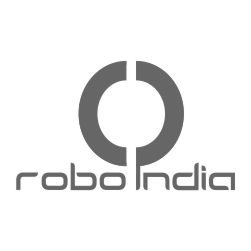Robo India presents PC controlled, You may control your robot through PC. Software is provided for Microsoft Windows.
1. Introduction:
A step by step guide for to make PC Controlled Robot using Robo India’s Motor Shield and Phantom Chassis. This can be made Xigbee based wire less robot by attaching Xigbee both side.
1.2 The motor shield
Robo India offers Arduino compatible Motor shield that can run 2 servo and 2 stepper or 4 DC motor. This shield uses shift register IC. Data is given in serial mode that is converted to parallel by this shift register IC. Connection are as follows.
Board to Shift Register-
- Digital Pin 8 – Data Pin
- Digital Pin 12 – Latch Pin
- Digital Pin 4 – Clock Pin
- Digital Pin 7 – Enable Pin
Shift Register to Motors-
- Q0 – M3 A
- Q1 – M2 A
- Q2 – M1 A
- Q3 – M1 B
- Q4 – M2 B
- Q5 – M4 A
- Q6 – M3 B
- Q7 – M4 B
2. Assembly and Connections
After assembling the robot make the connection as given in the following diagram. The Power Jumper on the motor shield works as Switch to motor it will be useful while debugging.
2.1 Assembly
Assembly of PC controlled robot is simple no need to assemble additional things than basic Phantom Chassis, Arduino Board and Shield.
2.2 Testing motor Connection
It is difficult to find GND and positive supply terminal of motor. Transfer the following code to the Arduino Board. The robot should move in forward direction, if it not doing so, interchange the of the wire of motor. e.g. suppose left motor is rotating in back ward direction and right motor is rotating in forward direction then you have to interchange the wires of M3 terminal.
You may download this sketch from here.
//Robo India Line follower Tutorial
// This codes runs robo int the forward direction.
// Shield Pins Declaration
int dataPin = 8;
int latchPin = 12;
int clockPin = 4;
int en = 7;
void setup()
{
pinMode(dataPin, OUTPUT); // Setting up the motor shield.
pinMode(latchPin, OUTPUT);
pinMode(clockPin, OUTPUT);
pinMode(en, OUTPUT);
digitalWrite(en, LOW);
forward(); // This funtion for forward robot motion
}
void loop()
{
}
void forward(void){
digitalWrite(latchPin, LOW);
shiftOut(dataPin, clockPin, LSBFIRST, 3);
digitalWrite(latchPin, HIGH);
}
void backward(void){
digitalWrite(latchPin, LOW);
shiftOut(dataPin, clockPin, LSBFIRST, 164);
digitalWrite(latchPin, HIGH);
}
void turn_left(void){
digitalWrite(latchPin, LOW);
shiftOut(dataPin, clockPin, LSBFIRST, 161);
digitalWrite(latchPin, HIGH);
}
void turn_right(void){
digitalWrite(latchPin, LOW);
shiftOut(dataPin, clockPin, LSBFIRST, 38);
digitalWrite(latchPin, HIGH);
}
void halt(void){
digitalWrite(latchPin, LOW);
shiftOut(dataPin, clockPin, LSBFIRST, 32);
digitalWrite(latchPin, HIGH);
}
2.3 Programming PC Controlled Robot –
The programme for PC controlled robot. This programme reads serial data and acts accordingly. Details of the data is mentioned ahead.
It has following predefined function for robot motion-
1. forward() : forward movement of robot.
2. backward() : backward movement of robot.
3. turn_left() : for turning left.
4. turn_right(): for turning right.
5. halt() : for stopping robot.
You may download this sketch from here.
// Robo India PC Controlled Tutorial
// www.roboindia.com
// declaring Motor Shield
int dataPin = 8;
int latchPin = 12;
int clockPin = 4;
int en = 7;
void setup()
{ // setting up Motor Shield.
pinMode(dataPin, OUTPUT);
pinMode(latchPin, OUTPUT);
pinMode(clockPin, OUTPUT);
pinMode(en, OUTPUT);
digitalWrite(en, LOW);
Serial.begin(9600); // Intializing Serial Communication.
}
void loop()
{
while(Serial.available())
{
char option = Serial.read();
switch (option)
{
case 70: // 70 is ASCII code for - F
forward();
break;
case 66: // 66 is ASCII code for - B
backward();
break;
case 76: // 76 is ASCII code for - L
turn_left();
break;
case 82: // 82 is ASCII code for - R
turn_right();
break;
case 83: // 83 is ASCII code for - S
halt();
break;
}
}
}
void forward(void){ // function for forward movement.
digitalWrite(latchPin, LOW);
shiftOut(dataPin, clockPin, LSBFIRST, 3);
digitalWrite(latchPin, HIGH);
}
void backward(void){ // function for forward movement.
digitalWrite(latchPin, LOW);
shiftOut(dataPin, clockPin, LSBFIRST, 164);
digitalWrite(latchPin, HIGH);
}
void turn_left(void){ // function for left turn.
digitalWrite(latchPin, LOW);
shiftOut(dataPin, clockPin, LSBFIRST, 161);
digitalWrite(latchPin, HIGH);
}
void turn_right(void){ // function for Right turn.
digitalWrite(latchPin, LOW);
shiftOut(dataPin, clockPin, LSBFIRST, 38);
digitalWrite(latchPin, HIGH);
}
void halt(void){ // function for stopping robot.
digitalWrite(latchPin, LOW);
shiftOut(dataPin, clockPin, LSBFIRST, 32);
digitalWrite(latchPin, HIGH);
}
2.3 Software
The software we are using here sends serial data to the comport at 9600 baud rate. The data and the related operations are as follows –
Forward – F
Backward – B
Left – L
Right – R
Stop – S
You may test the robot programme at serial terminal by sending above mentioned character set.
After downloading extract the folder and run .exe file. You will need to once disconnect your arduino USB cable, reconnect it and enter the port no. and press open button. If you enter correct port no., the other functions will be activated. Before closing the software press close button.
3. Resources:
This motor shield is based on Adafruit Motor Shield. Resources can be found here.
download software for PC Controlling.
If you have any query please write us at info@roboindia.com
our whatsapp helpline: +91 9694011188
Thanks and Regards
Content Development Team
Robo India
http://roboindia.com


